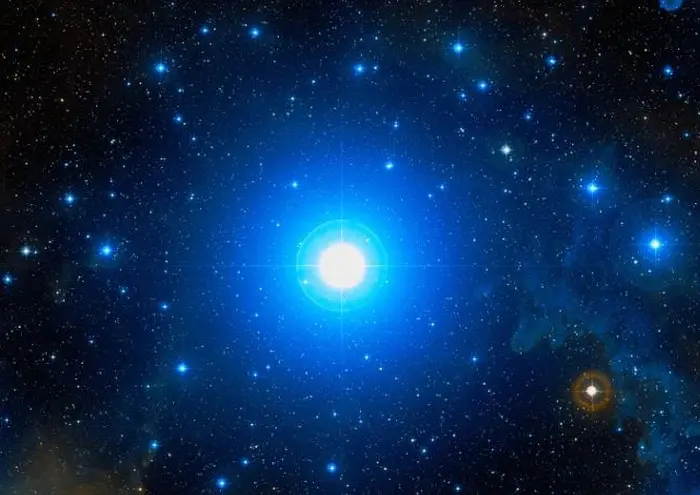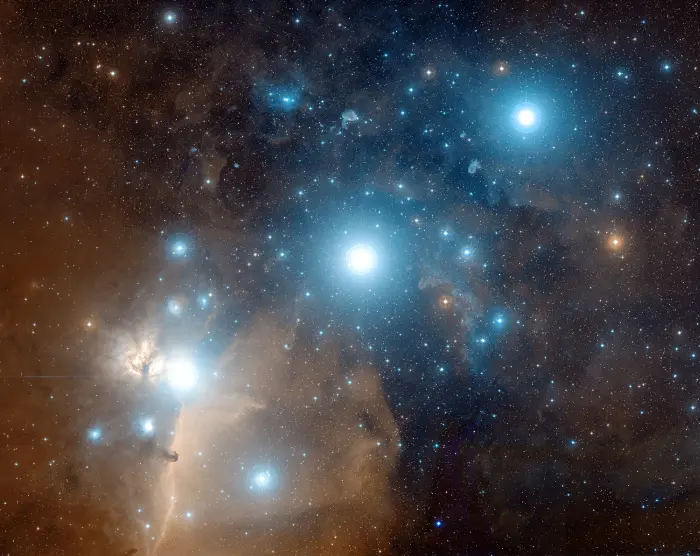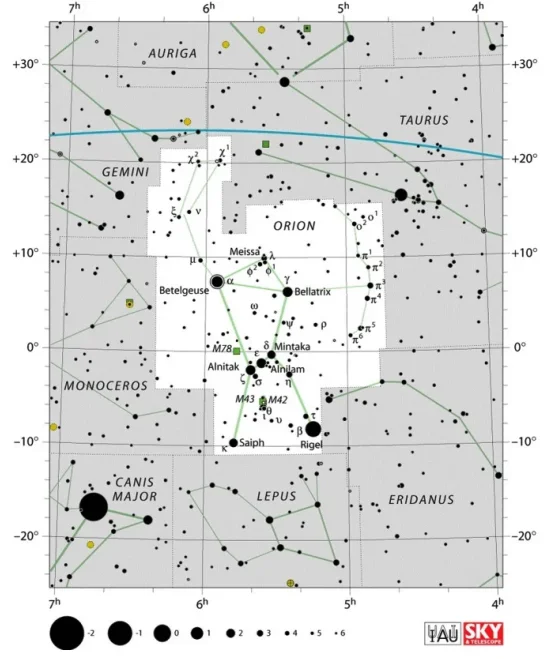Alnilam, Epsilon Orionis (ε Ori), is a bright blue supergiant star located approximately 1,180 light-years away in the constellation Orion. With an average apparent magnitude of 1.69, it is the fourth brightest star in Orion and the 29th brightest star in the sky. Alnilam is the middle star of Orion’s Belt, one of the best-known asterisms in the night sky. It appears between Alnitak and Mintaka.
Star type
Alnilam is a blue-white supergiant star of the spectral type B0 Ia. It has a mass 40 times that of the Sun and a radius of 30.62 solar radii. With a surface temperature of 26,540 kelvin, it is 419,600 times more luminous than the Sun. The star is a fast spinner, with a projected rotational velocity of 80 km/s. It has an estimated age of only 4.47 million years.
Alnilam is classified as an Alpha Cygni variable. Like the supergiant Deneb (Alpha Cygni) in the constellation Cygnus (the Swan), Epsilon Orionis varies in brightness due to pulsations. Its brightness has been observed to vary between magnitude 1.64 and 1.74 without a clear period.

Alnilam (Epsilon Orionis), image credit: ESO/Digitized Sky Survey 2 (CC BY 4.0)
Alpha Cygni variables are hot, evolved supergiant stars with the spectral classification B or A, that exhibit changes in brightness because of non-radial pulsations. Some portions of their surface contract while others simultaneously expand. Other relatively bright stars in this class include Rigel in Orion, Aludra and Omicron2 Canis Majoris in Canis Major, Kappa Cassiopeiae in Cassiopeia, and Rho Leonis in Leo.
Alnilam’s stellar winds can reach speeds of up to 2,000 km/s. As a result, the star loses mass at a rate 20 million times greater than the Sun.
Even though it is only a few million years old, Alnilam is already fusing heavy elements in its core. Because of its high mass loss rate, it will likely not evolve into a red supergiant, but rather into a Wolf-Rayet star in the next million years. When it goes out as a supernova, the star will probably leave behind a black hole, not a neutron star.
Alnilam’s physical properties are still mostly uncertain and different surveys have yielded different results over the years. In 2006, a team of scientists used atmospheric modelling and found that the star had a radius of 24 solar radii, a luminosity 275,000 times that of the Sun and a temperature of 27,000 K. In 2008, a different team analysed Alnilam’s spectrum and calculated a radius of 32.4 times that of the Sun, a luminosity of 537,000 solar luminosities and an effective temperature of 27,500 K.
A 2015 survey of the star across several wavelengths, assuming the distance of 2,000 light years, gave a luminosity of 832,000 L☉, the highest to date for the star.
A 2020 study found a mass of 40 solar masses and a radius 30.62 times that of the Sun, based on the surface temperature of 26,540 K and a luminosity derived in the evolutionary models of Ekström et al. (2012).

Orion stars, image credit: ESO/Digitized Sky Survey 2 (CC BY 4.0)
Orion’s Belt
Alnilam is the central star of Orion’s Belt, an asterism known since ancient times. Orion’s Belt is also formed by the bright stars Alnitak (Zeta Orionis) and Mintaka (Delta Orionis). Alnilam is the only single star of the three, as well as the brightest. Both Alnitak and Mintaka are multiple star systems.
Alnitak appears only slightly fainter than Alnilam. It is on average the 31st brightest star in the sky, while Mintaka is the 73rd brightest star.
Until recently, Alnilam was believed to be the most distant of the three stars, located over 2,000 light years away. However, the distance of 361 parsecs (1,180 light-years), derived from a 2023 spectroscopic study of Orion’s Belt stars, places the supergiant closer to its Orion’s Belt neighbours. Alnitak lies approximately 1,260 light-years away and Mintaka, 1,200 light-years away.
The three stars have a common origin and share the same proper motion, which is why Orion’s Belt has retained an almost identical shape since prehistoric times. The stars are the most massive members of the Orion OB1b association, a young stellar association formed within the larger Orion molecular cloud complex.
Orion’s Belt stars have been known across many different cultures since ancient times. The English folk names for the three stars include Peter’s Staff, Jacob’s Rod (Staff), the Yard-stick, the Golden Yard-arm, the Three Kings (the Magi), the Three Marys and Our Lady’s Wand.

Orion’s Belt, image: Davide De Martin (http://www.skyfactory.org); Credit: Digitized Sky Survey, ESA/ESO/NASA FITS Liberator (PD)
In South America and Portugal, the stars are known as “Las Tres Marías” (Spanish) and “As Três Marias” (Portuguese). In Puerto Rico and the Philippines, they are associated with the Biblical Magi and called “Los Tres Reyes Magos.”
Arabic names for the stars include Al Nijād (the Belt), Al Alkāt (the Golden Nuts or the Golden Grains) and the modern Arabic name, Al Mīzān al Ḥaqq (the Accurate Scale Beam), while the Chinese know them as the Weighing Beam. The Chinese also call them Three Stars (參宿). Other bright stars of Orion – Betelgeuse, Rigel, Bellatrix, and Saiph – were later included in the Three Stars asterism.
Ancient Egyptians associated Orion and Sirius with Osiris and his wife, and believed that gods came from Orion’s Belt and Sirius to start the human race. The air shafts in the pyramids, believed to be there to send the pharaoh’s soul toward Orion, point toward the constellation. The alignment of the three pyramids of Giza is believed by some to represent the Belt of Orion, but the Orion correlation theory has been heavily contested.
Facts
Shining at magnitude 1.69, Alnilam is the 4th brightest star in the constellation Orion, after Rigel (Beta Orionis), Betelgeuse (Alpha Orionis), and Bellatrix (Gamma Orionis). The blue-white supergiant is, on average, the 29th brightest star in the sky. It is only slightly fainter than Elnath in the constellation Taurus and Miaplacidus in Carina, and it just outshines Alnair in Grus, its Orion neighbour Alnitak, and Alioth, the brightest star in Ursa Major.
The stars of Orion’s Belt – Alnilam, Alnitak and Mintaka – form an asterism known as Venus’ Mirror with the stars of Orion’s Sword and Eta Orionis. The four-sided pattern is sometimes also called the Saucepan.

Orion’s Belt and Venus Mirror, image: Stellarium
Alnilam is one of the four Orion stars used in the field of celestial navigation, along with Rigel, Betelgeuse, and Bellatrix. These are the four brightest stars in Orion. They outline Orion’s hourglass figure with Saiph, the constellation’s sixth brightest star, and Orion’s Belt stars Alnitak and Mintaka. Navigational stars are some of the brightest and most identifiable stars in the sky. They were selected for use in celestial navigation both because they appear so bright and because they are either part of a recognizable star pattern or located near one.
In 1786, German-born British astronomer Sir William Herschel reported the discovery of a nebula around Alnilam. He observed the nebula on February 1, 1786. The reflection nebula is listed as NGC 1990 in the New General Catalogue. However, it is unclear whether or not this object really exists because modern instruments have not been able to pinpoint its exact location and size.
Name
The name Alnilam (pronunciation: /ˈælnɪlæm/) is derived from the Arabic al-niẓām, meaning “string of pearls.” It was historically also spelled Anilam, Alnihan, Ainilam, Al Nathm, Alnitam, and Al Nitham.
The name Alnilam was officially approved by the International Astronomical Union’s (IAU) Working Group on Star Names (WGSN) on July 20, 2016.
In traditional Chinese astronomy, Alnilam is known as 參宿二 (Shēn Sù èr), the Second Star of Three Stars. The Three Stars asterism is also formed by Alnitak (Zeta Orionis), Mintaka (Delta Orionis), Betelgeuse (Alpha Orionis), Bellatrix (Gamma Orionis), Saiph (Kappa Orionis), and Rigel (Beta Orionis). The asterism is part of the larger Three Stars mansion, which represents the body of the White Tiger.
Location
Alnilam and other bright stars of Orion are very easy to find because the constellation’s hourglass figure dominates the evening sky during the northern hemisphere winter. The bright Betelgeuse and Bellatrix mark the Hunter’s shoulders, Saiph and Rigel his feet, and Alnitak, Alnilam and Mintaka his belt.
The stars of Orion’s Belt are easy to identify because they stand prominently in the middle of Orion’s conspicuous constellation figure. Alnilam is the middle star of the Belt. From the northern hemisphere, Alnitak appears to the left and Mintaka to the right. From the southern hemisphere, the constellation figure of Orion appears upside down.
Orion’s Belt stars can be used to find other bright stars in the vicinity. Going east, they point in the direction of Sirius in Canis Major, the brightest star in the sky. To the west they point toward Aldebaran, the brightest star in Taurus, and the Pleiades cluster (M45). The famous Orion Nebula (M42) appears just below the Belt, in Orion’s Sword.

The location of Alnilam (Epsilon Orionis), image: Stellarium

Orion’s Belt and the Orion Nebula (M42), image: image credit: ESO/Digitized Sky Survey 2 (CC BY 4.0)
Constellation
Alnilam is located in the constellation Orion, one of the most recognizable constellations in the sky. Orion is one of the Greek constellations, catalogued by the Greco-Roman astronomer Claudius Ptolemy of Alexandria in his Almagest in the 2nd century CE. In Greek mythology, the constellation is associated with the giant huntsman Orion, known for his supernatural strength and skill.
Orion occupies an area of 594 square degrees and is the 26th largest constellation in the sky. It is also one of the brightest constellations. It contains more first and second magnitude stars than any other constellation.
Orion hosts the supergiants Rigel and Betelgeuse, the seventh and 10th brightest stars in the sky. The constellation is known for its many young, exceptionally massive and luminous stars. These include the blue supergiants Rigel, Saiph, and Alnitak, the red supergiant Betelgeuse, the blue giants Meissa and Hatysa, the bright giant Mintaka, and the hot blue main sequence star Bellatrix.

Orion constellation map by IAU and Sky&Telescope magazine
The best-known deep sky objects in Orion include the Orion Nebula (Messier 42) with the Trapezium Cluster, the neighbouring De Mairan’s Nebula (Messier 43), the emission nebulae Barnard’s Loop and the Flame Nebula (NGC 2024), the reflection nebula Messier 78, and the dark nebula Barnard 33, also known as the Horsehead Nebula.
For observers in the northern hemisphere, Orion is prominent in the night sky from November to May and can also be seen in the early morning hours from late July to November. For southern observers, Orion appears upside down and is best seen during the summer months.
The best time of the year to observe the stars and deep sky objects in Orion is during the month of January, when the constellation appears higher above the horizon in the early evening. The entire constellation is visible from locations between the latitudes 85° N and 75° S.
The 10 brightest stars in Orion are Rigel (Beta Ori, mag. 0.05 – 0.18), Betelgeuse (Alpha Ori, mag. 0.0 – 1.3), Bellatrix (Gamma Ori, mag. 1.59 to 1.64), Alnilam (Epsilon Ori, mag. 1.64 – 1.74), Alnitak A (Zeta Ori A, mag. 2.00), Saiph (Kappa Ori, mag. 2.09), Mintaka AB (Delta Ori AB, mag. 2.23), Hatysa (Iota Ori, mag. 2.77), Tabit (Pi3 Ori, mag. 3.16), and Eta Orionis (mag. 3.31 – 3.6).
Alnilam – Epsilon Orionis
| Spectral class | B0 Ia |
| Variable type | Alpha Cygni |
| U-B colour index | −1.03 |
| B-V colour index | −0.18 |
| Apparent magnitude | 1.69 (1.64 – 1.74) |
| Absolute magnitude | −6.89 |
| Distance | 1,180 light-years (361 parsecs) |
| Parallax | 1.65 ± 0.45 mas |
| Radial velocity | 27.30 ± 0.8 km/s |
| Proper motion | RA: 1.44 ± 0.42 mas/yr |
| Dec.: −0.78 ± 0.19 mas/yr | |
| Mass | 40 M☉ |
| Luminosity | 419,600 L☉ |
| Radius | 30.62 R☉ |
| Temperature | 26,540 K |
| Age | 4.47 million yeas |
| Rotational velocity | 80 km/s |
| Surface gravity | 3.02 cgs |
| Constellation | Orion |
| Right ascension | 05h 36m 12.81335s |
| Declination | −01° 12′ 06.9089″ |
| Names and designations | Alnilam, Epsilon Orionis, ε Orionis, ε Ori, 46 Orionis, 112 G Orionis, HD 37128, HR 1903, HIP 26311, SAO 132346, FK5 210, BD -01 969, AG-01 596, ALS 14791, PPM 175945, TD1 4963, GC 6960, GCRV 3454, PLX 1283.00, CEL 852, IRAS 05336-0113, 2MASS J05361280-0112070, CSI-01 969 1, 2E 0533.6-0113, 2E 1411, 2E 0533.6-0113, EM* MWC 504, MCW 342, N30 1204, ROT 885, EUVE J0536-01.1, PMC 90-93 151, HGAM 449, RAFGL 4428S, JP11 1181, UBV 5563, UBV M 11224, SKY# 9067, WEB 5173, WH 328, uvby98 100037128, GEN# +1.00037128, IRC +00079, TYC 4766-2450-1, TIC 427451176, Ced 55h, 1RXS J053619.2-011312, 1RXS J053612.8-011201, CCDM J05363-0112A, IDS 05311-0116 A, WDS J05362-0112A |